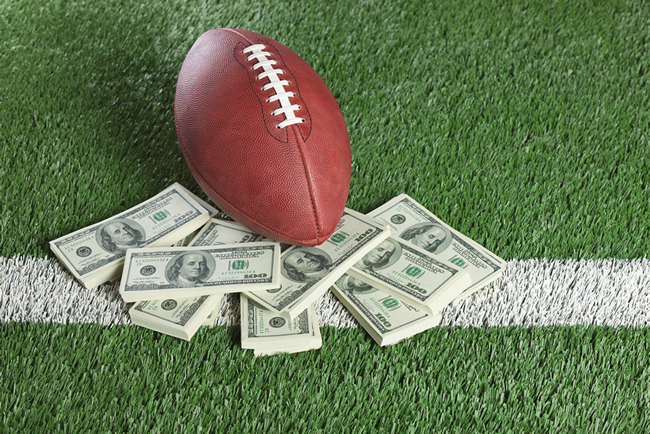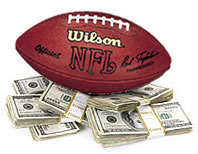
Fantasy Football For Cash Money
How much of your cash should you commit to this week’s fantasy football contests?
What are your chances of winning the next large-field NFL GPP at DraftKings?
Most importantly, by the end of the month, will you have more money sitting in your DFS account or less?
These are some of the questions that might be going through head. And for good reason. You want to end up with more money than you started with.
The key to long-term profitability in fantasy football has little to do with how many contests you win or lose during any given week. Don’t get me wrong. Your wins and losses matter, of course. But they’re far less important than how you manage your money.
That’s what we’ll cover below. I’m going to show you how to create a plan that allows you to lose more contests than you win, and still come out ahead.
Your Mission (If You Choose To Accept It)
I’m going to assume you want to earn a profit. Although playing daily fantasy is a lot of fun, any joy you get from participating will evaporate if you keep hemorrhaging cash.
So, your mission is to become a profitable fantasy football team owner.
I’m not talking about getting lucky in Week 10 and scoring a major GPP win (although that would be great!). Rather, I’m talking about creating a solid bankroll management strategy that all but ensures your winnings outstrip your losses on a monthly basis.
Playing one-week fantasy football isn’t like throwing darts at a board. Yes, there’s an ever-present risk of loss. But with smart planning built on reliable data, you can sidestep the long-term risk and make a consistent profit.
What Does It Take To Earn A Profit In Fantasy Football?
All other variables being equal, profitability varies by contest format. That’s because format dictates payout distribution across the field.
Consider 50/50s and head-to-heads. Half the field gets paid twice the buy-in less 10% for the rake. For example, a $20 50/50 will pay $36 to each team owner who finishes in the top 50% of the field.
That means you need to win 60% of the 50/50s and H2Hs you enter in order to turn a profit. (Note: you need to win more than 1/2 of the contests just to break even due to the rake.)
Now, consider GPPs. Payout distributions vary by tournament, but typically fall between 15% and 20% of the field. Winners who finish in the bottommost part of that payout structure usually earn twice the buy-in (sometimes less).
Given that GPPs generally pay out to the 80th percentile, and assuming you finish in that percentile (i.e. you barely make it into a position that earns a payout), you’d need to win 50% of the GPPs you enter to break even.
Now, consider small-field, winner-take-all leagues. In these types of contests, the top scorer receives the entire prize pool. Everyone else loses.
Given that, you’d only need to win 12% of such leagues to make a profit.
Quick recap: we now know what it takes to be profitable in various contest formats. But we still don’t know how likely it is that we’ll achieve the above percentages. Stay with me. Later, I’ll show you how to use those percentages to come up with a reliable bankroll management plan.
How Much Of Your Bankroll Should You Risk Each Week?
 The amount of cash you should put in play during any given week of fantasy football will depend on 2 main factors:
The amount of cash you should put in play during any given week of fantasy football will depend on 2 main factors:
1. your experience level
2. your win/loss record
In the past, I’ve recommended that beginners limit their weekly spend to 5% of their bankroll. So, if you have $1,000 in your account, don’t risk more than $50 per week.
That recommendation assumes you’re a novice with zero experience. Your goal at that point should be to learn how DFS works and how to compete in different types of contests.
After you’ve competed in a few 50/50s, double-ups, small-field leagues and large-field GPPs, you should feel comfortable raising the weekly limit to 10%, or even 15%. Your new goal is to amass a track record of wins and losses. That track record will help you to decide how and where to allocate your cash.
Here, we get into the concept of ROI.
How To Plan Your Weekly Spend Based On Past ROI
When you’re starting out in fantasy football, you don’t have a win/loss record. The slate is clean. Unfortunately, that being the case, there’s no way to calculate your “expected winnings.” And if you can’t calculate your expected winnings, you won’t have the necessary data to determine the best use of your money.
Expected winnings is just an expression of ROI (return on investment). If you know the ROI attached to your record in a particular type of contest, you can figure out whether – and how much – you should compete in that contest format.
For example, let’s say you’ve been playing one-week fantasy football since the beginning of the season. Over the last couple months, you’ve kept track of your wins and losses. Let’s say your record looks like the following for GPPs:
Wins: 20
Losses: 18
Total buy-ins: $190
Profit/Loss: $200
ROI: 5.2%
Let’s also say you’ve likewise tracked your wins and losses for 50/50s, H2Hs and small leagues over the course of the season. Following is a list of your ROIs by contest format.
GPPs: 5.2%
50/50s: 23.6%
H2Hs: 12.1%
Small leagues: 16.5%
The above means you’ve earned $5.20 in profit for every $100 in GPP buy-ins. You’ve earned $23.60 in profit for every $100 you’ve spent to compete in 50/50s. And so on.
You can immediately tell from the numbers above that you’re doing best in 50/50s and small leagues. While you’re managing to squeeze out a small profit in GPPs, they’re not your strength.
That’s important data. You can use it to determine where the majority of your weekly spend should go. After all, if you know you’ll earn a 23.6% return on 50/50s, and only a quarter of that return on GPPs, why spend all of your cash and time on tournaments?
Review Your Win/Loss Record And Adjust Accordingly
Your win/loss record is going to change over time. Hopefully, it will improve as you gain more experience and develop a better draft strategy.
The key is that every change in your win/loss record will effect a change in the associated ROI. When that happens, it’s important to adjust the allocation of your bankroll to reflect the new data.
For example, suppose you’ve gotten the hang of competing in GPPs. Your win/loss record has improved dramatically. As a result, your ROI on GPPs has risen from 5.2% to 17.4%.
According to our hypothetical win/loss record (see above), 50/50s are still your best bet with a 23.6% ROI. But you now know that your improved ROI in GPPs (17.4%) is greater than your ROI in H2Hs (12.1%). That means you can earn a larger overall profit by increasing your spend in GPPs while decreasing your spend in H2Hs.
It’s worth underscoring that your win/loss record is never static. The outcome of every contest you enter will change the ROI associated with that contest format. Track your results and adjust your bankroll allocation to take full advantage of the formats in which you perform the best.
Focus On Increasing Your ROI In Each Contest Format
 From the discussion thus far, you can see why focusing on individual wins and losses in fantasy football is a waste of time and energy – at least when it comes to bankroll management. It’s far more important to focus on ROI.
From the discussion thus far, you can see why focusing on individual wins and losses in fantasy football is a waste of time and energy – at least when it comes to bankroll management. It’s far more important to focus on ROI.
Remember, your ROI informs your bankroll allocation.
Once you know your ROIs for the various types of fantasy football contests you enjoy competing in, don’t rest on your laurels. This isn’t a mutual fund where you check your monthly statement and then forget about your investment until the following month.
You should always try to increase your ROIs.
Every incremental improvement translates into more profit. Additionally, ROI improvements can lead to bigger monthly profits as you shift your portfolio of contests to reflect your revised track record of wins and losses.
Let’s take a breather from the numbers and talk about expectations.
Manage Your Expectations In Weekly Fantasy Football
When you’re starting out, it’s natural to have lofty expectations about your chances of cashing. After all, you love pro football and know plenty about the top players. You’ve heard that thousands of football fans are making money in daily fantasy and figure you have a good shot at doing the same.
The reality is that only a small percentage of DFS team owners make a consistent profit.
Sure, there are lots of guys (and gals) who stumble into a major win and take home a pile of money thanks to their good fortune. But it’s the rare team owner who can make that happen week after week.
It’s important to temper your expectations. Not everyone is a consistent winner. Even team owners who seem to have the Midas touch lose more contests than they win. That’s the reality of one-week fantasy football.
One of the keys to their success is knowing how to manage their money. They know how to best allocate their bankroll based on their track records.
As you play more fantasy football, you’ll collect more and more data that reflect your wins, losses and resultant ROIs. Those data will not only help you to make smart decisions regarding your bankroll, but will also help you to maintain realistic expectations about your chances of cashing in different types of contests.
Until you accumulate it, keep a lid on your expectations. That way, you’re not tempted to risk your bankroll chasing elusive wins.
Is It Possible To Plan Your Fantasy Football Income?
A lot of DFSers treat weekly fantasy football as if they’re rolling a pair of dice. It’s as if they don’t believe they wield any influence over their results. So they treat the contests like games of chance.
You can do better than that.
I’ve just given you a blueprint for managing your bankroll in such a way that you maximize your odds of earning a consistent profit. Obviously, this isn’t like a 9-to-5 job where you’ll receive a paycheck even if you fall asleep at your desk. You have to stay on your toes and always look for opportunities to improve your ROI.
That’s good news! It means if you’re willing to roll up your sleeves and do the work, you can figure out a way to make one-week fantasy football pay off on a consistent basis.
Related links:
Establishing Bankroll Metrics
Grinders guide to bankroll building
Basic Bankroll Management